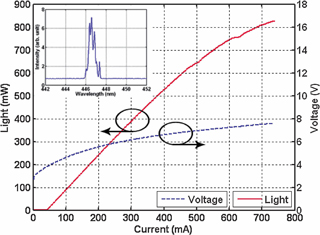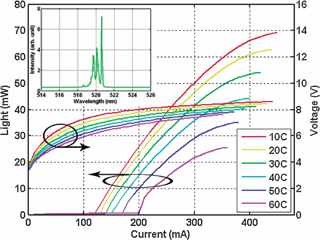- News
15 November 2010
Non-polar nitride boost to blue and true-green laser diode performance
Soraa Inc of Goleta CA, USA has published performance details of record high-efficiency blue laser diodes (LDs) built on non-c-plane gallium nitride (GaN) semiconductors substrates [James W. Raring et al, Appl. Phys. Express, vol3, p112101, 2010]. The company has also developed true-green laser diodes for which it expects ‘substantial performance improvements’ in the coming months.
Soraa works on developing III-nitride semiconductors, ‘focusing on disruptive energy-saving solutions’. The firm was founded in 2008 (as parent company to Kaai Inc) by University of California Santa Barbara (UCSB) professors Shuji Nakamura, Steve DenBaars, and Jim Speck, whose names appear on the Soraa paper.
Light emission from indium gallium nitride (InGaN) devices power an increasing number of applications, including biomedical instrumentation and therapies, imaging, reprographics, scientific research, defense, security, data storage, and projection displays.
The present commercial InGaN technology uses c-plane substrates that suffer from polarization electric fields, mainly arising from piezoelectric strain effects. These fields tend to reduce the overlap between the electron and hole carriers, reducing their chances of recombining as suitable photons. By working with other orientations of the nitride crystal structure it is hoped to reduce the polarization fields and thus increase recombination and hence the efficiency of light-emitting devices. Non-c-plane {20-21} orientations were used by Sumitomo in 2009 to extend laser diode performance into the true-green region of the spectrum (520–570nm), with pulsed lasing at 531nm and continuous wave (CW) lasing at 520nm.
The Soraa report is rather coy about the device structure and does not give any details about particular nitride orientations used. Possibly the company wants to keep this useful information to itself for commercial advantage and is perhaps indicative that sample devices will be available from Soraa in the near future. The multi quantum well (MQW) laser structures were grown on free-standing GaN substrates with ‘selected orientations’, using ‘conventional’ processing technology. Some clues to the structures would no doubt emerge from a search and study of UCSB’s recent work.
The epitaxial MQW structures were formed into laser cavities measuring 600μm and 900μm in length and with widths in the range 1.5–2.5μm. The laser diodes had surface ridge architectures, aiming at a single lateral mode. The epitaxial material was processed further to apply metal for contact pads, and the result was then singulated, mounted and assembled into standard transistor outline (TO) can packages.
 The researchers are claiming the highest CW wall-plug efficiency (WPE) and light output power values ‘reported to date’ for blue laser diodes emitting at 447nm wavelengths (Figure 1). One device with a 900μm cavity had kink-free operation up to 750mW, and powers in excess of 800mW were achieved. The peak WPE for this device was 22% at 200mW. A 600μm cavity device achieved a WPE of 23.2% at 180mW. These results beat a previous achievement of 18% WPE by OSRAM Opto Semiconductors of Regensburg, Germany for a c-plane device reported earlier this year.
The researchers are claiming the highest CW wall-plug efficiency (WPE) and light output power values ‘reported to date’ for blue laser diodes emitting at 447nm wavelengths (Figure 1). One device with a 900μm cavity had kink-free operation up to 750mW, and powers in excess of 800mW were achieved. The peak WPE for this device was 22% at 200mW. A 600μm cavity device achieved a WPE of 23.2% at 180mW. These results beat a previous achievement of 18% WPE by OSRAM Opto Semiconductors of Regensburg, Germany for a c-plane device reported earlier this year.
Figure 1: CW light-output vs current and voltage (LIV) characteristics of single-mode blue-emitting laser diode. Inset: lasing spectrum at 447nm.
The threshold current/voltage values for the 900μm and 600μm Soraa devices were 45mA/3.8V and 30mA/3.8V, respectively. The corresponding slope efficiencies were 1.55W/A and 1.62W/A. The measurements were carried out at case temperatures of 25°C.
Further testing involved varying the temperature of 600μm devices. The threshold current temperature characteristic (T0) was 130K, which falls in the ‘typical’ range of 125–140K that Soraa has for its other devices. (High values of T0 are desirable.) The WPE was more than 20% at 100mW and more than 22% at 180mW at all case temperatures in the range 10–70°C. The highest peak WPE achieved was 23.6% at a case temperature of 50°C and 200mW output power.
Operating lifetimes of five devices were determined by operating at 40°C for more than 2000 hours with 60mW output power. Using a linear extrapolation of the operating current increase needed to maintain 60mW output, the mean lifetime was ~10,000 hours, with a spread of 8000–23,300 hours.
 A true-green laser diode emitting at about 521nm was also presented (Figure 2). Since producing true-green LDs is still very challenging, it is no surprise to see WPE values an order of magnitude less in size. At 20°C, the threshold current and voltage were 130mA and 7.3V, respectively. The peak WPE is given as 1.92%. The slope efficiency was more than 0.3W/A, and output powers of more than 60mW were reached. By varying the temperature, the T0 value was determined to be 160–180K in pulsed operation (avoiding self-heating effects). Lifetime measurements are reported to be ‘underway’.
A true-green laser diode emitting at about 521nm was also presented (Figure 2). Since producing true-green LDs is still very challenging, it is no surprise to see WPE values an order of magnitude less in size. At 20°C, the threshold current and voltage were 130mA and 7.3V, respectively. The peak WPE is given as 1.92%. The slope efficiency was more than 0.3W/A, and output powers of more than 60mW were reached. By varying the temperature, the T0 value was determined to be 160–180K in pulsed operation (avoiding self-heating effects). Lifetime measurements are reported to be ‘underway’.
Figure 2: CW–LIV characteristics at case temperatures of 10–70°C of a green-emitting laser diode. Inset: lasing spectrum at 521nm at case temperature of 20°C.
Although the true-green device does not match the performance under CW conditions of 2.3% WPE at 50mW output power by Osram Opto on c-plane GaN, the researchers contrast the 15-year development with their own 15 months on non-c-plane material ‘with substantial performance improvements expected in the months to come’.
For both blue and true-green devices, the full-width at half maximum (FWHM) of the spectral enveloped was about 1nm. The FWHM divergence angles in the ‘slow’ (due to width of active region) and ‘fast’ (due to epitaxial layer thickness of active region) axis directions were 9–12° and 15–18°, respectively, for the blue devices. The true-green device had the same slow-axis range, but a slightly tighter fast-axis range of 13–17°.
UCSB achieves CW operation of AlGaN-cladding-free nonpolar lasers
Kaai starts shipping blue laser for display and specialty applications
Soraa Blue laser diodes Green laser diodes Non-c-plane GaN substrates
The author Mike Cooke is a freelance technology journalist who has worked in the semiconductor and advanced technology sectors since 1997.
